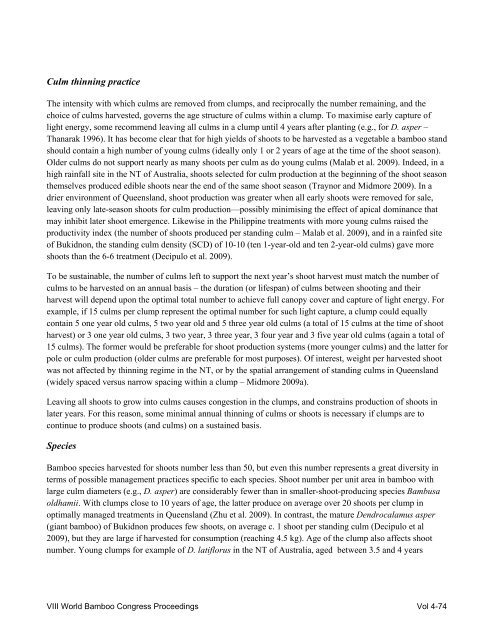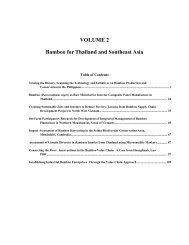WBC-VIII-Vol.4 – Resources – Forestry, Plantations and ... - BambuSC
WBC-VIII-Vol.4 – Resources – Forestry, Plantations and ... - BambuSC
WBC-VIII-Vol.4 – Resources – Forestry, Plantations and ... - BambuSC
You also want an ePaper? Increase the reach of your titles
YUMPU automatically turns print PDFs into web optimized ePapers that Google loves.
Culm thinning practice<br />
The intensity with which culms are removed from clumps, <strong>and</strong> reciprocally the number remaining, <strong>and</strong> the<br />
choice of culms harvested, governs the age structure of culms within a clump. To maximise early capture of<br />
light energy, some recommend leaving all culms in a clump until 4 years after planting (e.g., for D. asper <strong>–</strong><br />
Thanarak 1996). It has become clear that for high yields of shoots to be harvested as a vegetable a bamboo st<strong>and</strong><br />
should contain a high number of young culms (ideally only 1 or 2 years of age at the time of the shoot season).<br />
Older culms do not support nearly as many shoots per culm as do young culms (Malab et al. 2009). Indeed, in a<br />
high rainfall site in the NT of Australia, shoots selected for culm production at the beginning of the shoot season<br />
themselves produced edible shoots near the end of the same shoot season (Traynor <strong>and</strong> Midmore 2009). In a<br />
drier environment of Queensl<strong>and</strong>, shoot production was greater when all early shoots were removed for sale,<br />
leaving only late-season shoots for culm production—possibly minimising the effect of apical dominance that<br />
may inhibit later shoot emergence. Likewise in the Philippine treatments with more young culms raised the<br />
productivity index (the number of shoots produced per st<strong>and</strong>ing culm <strong>–</strong> Malab et al. 2009), <strong>and</strong> in a rainfed site<br />
of Bukidnon, the st<strong>and</strong>ing culm density (SCD) of 10-10 (ten 1-year-old <strong>and</strong> ten 2-year-old culms) gave more<br />
shoots than the 6-6 treatment (Decipulo et al. 2009).<br />
To be sustainable, the number of culms left to support the next year’s shoot harvest must match the number of<br />
culms to be harvested on an annual basis <strong>–</strong> the duration (or lifespan) of culms between shooting <strong>and</strong> their<br />
harvest will depend upon the optimal total number to achieve full canopy cover <strong>and</strong> capture of light energy. For<br />
example, if 15 culms per clump represent the optimal number for such light capture, a clump could equally<br />
contain 5 one year old culms, 5 two year old <strong>and</strong> 5 three year old culms (a total of 15 culms at the time of shoot<br />
harvest) or 3 one year old culms, 3 two year, 3 three year, 3 four year <strong>and</strong> 3 five year old culms (again a total of<br />
15 culms). The former would be preferable for shoot production systems (more younger culms) <strong>and</strong> the latter for<br />
pole or culm production (older culms are preferable for most purposes). Of interest, weight per harvested shoot<br />
was not affected by thinning regime in the NT, or by the spatial arrangement of st<strong>and</strong>ing culms in Queensl<strong>and</strong><br />
(widely spaced versus narrow spacing within a clump <strong>–</strong> Midmore 2009a).<br />
Leaving all shoots to grow into culms causes congestion in the clumps, <strong>and</strong> constrains production of shoots in<br />
later years. For this reason, some minimal annual thinning of culms or shoots is necessary if clumps are to<br />
continue to produce shoots (<strong>and</strong> culms) on a sustained basis.<br />
Species<br />
Bamboo species harvested for shoots number less than 50, but even this number represents a great diversity in<br />
terms of possible management practices specific to each species. Shoot number per unit area in bamboo with<br />
large culm diameters (e.g., D. asper) are considerably fewer than in smaller-shoot-producing species Bambusa<br />
oldhamii. With clumps close to 10 years of age, the latter produce on average over 20 shoots per clump in<br />
optimally managed treatments in Queensl<strong>and</strong> (Zhu et al. 2009). In contrast, the mature Dendrocalamus asper<br />
(giant bamboo) of Bukidnon produces few shoots, on average c. 1 shoot per st<strong>and</strong>ing culm (Decipulo et al<br />
2009), but they are large if harvested for consumption (reaching 4.5 kg). Age of the clump also affects shoot<br />
number. Young clumps for example of D. latiflorus in the NT of Australia, aged between 3.5 <strong>and</strong> 4 years<br />
<strong>VIII</strong> World Bamboo Congress Proceedings Vol 4-74




